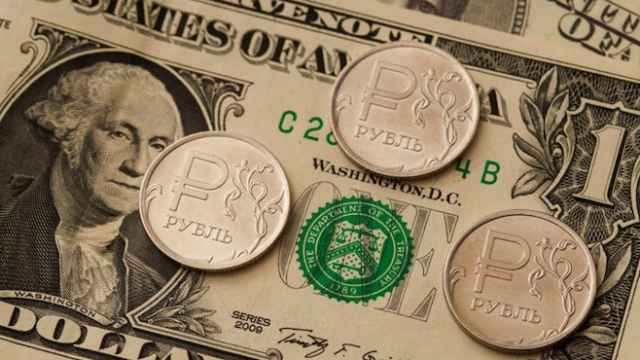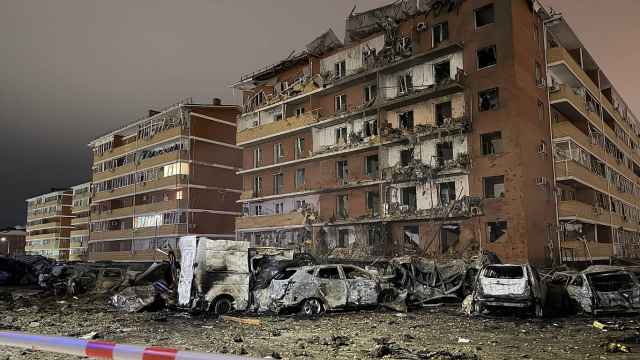Russia's ruble extended a months-long losing streak on Monday, falling to new historic lows and hovering just below the level at which the Central Bank has said it would take action to defend the currency.
The ruble fell sharply in morning trading, edging steadily toward the psychologically significant mark of 40 rubles per one U.S. dollar. By 12:35 p.m., a dollar was worth 39.58 rubles, the Russian currency's lowest point since it was restructured during Moscow's traumatic 1998 debt default.
The ruble has lost more than 20 percent of its value against the greenback this year as international tensions over Ukraine have spiked and the West has imposed sanctions on Russia for its annexation of the Ukrainian region of Crimea and support for separatists in Ukraine's eastern regions.
“The market is more and more being seized by panic,” ING's chief economist in Russia, Dmitry Polevoy, wrote in a note to investors Monday.
Russian equity markets followed the ruble on its downward slide Monday with the MICEX Index closing down 1.8 percent at 1,408. The dollar-denominated RTS Index fell 2.6 percent to 1,126.
The ruble weakened to 50.21 rubles against the euro, its lowest level since May, as support provided by Russian companies buying rubles for monthly tax payments faded.
Time to Intervene?
Driven by the ruble's weakness against the dollar and the euro, the Central Bank's currency basket — a weighted combination of the two currencies that the bank uses to measure the ruble's value — fell to its lowest level since the benchmark was introduced in 2005. During morning trading the ruble reached 44.37 against the currency basket – just 30 kopeks away from the upper limit of the ruble trading corridor, where the Central Bank has committed to begin interventions to stop devaluation.
“It is clear that the ruble's dynamic this year has been primarily driven by geopolitics,” Raiffeisen analysts said in a note Monday. “In particular, recently the main negative factor for the ruble has been, by our calculations, the refinancing of external corporate debts.”
The currency has also been weakened by a sliding oil price and global pressures on emerging markets.
Andrei Belousov, an economic aide to President Vladimir Putin, was quoted by Interfax on Monday as saying the ruble was “over-weakened” in comments that some interpreted as evidence of jitters in officialdom.
“The Russian authorities are nervous,” Timothy Ash, head of emerging market research at Standard Bank, said in e-mailed comments.
The Central Bank has no daily limit on how much it can intervene on currency markets, a move that is now likely to be around the corner but that it has not made since May. The regulator's guidelines say it should start buying rubles with hard currency when the ruble butts up against the outer limit of its trading corridor. With every $350 million spent, the corridor should be expanded by 5 kopecks.
Delay the Free Float
“There is a definite sense that being so close to intervention levels, the market wants to test the Central Bank to see how it will react,” said Tom Levinson, a currency strategist at Sberbank CIB.
The Central Bank spent over $72 billion in the first three months of this year to prop up the ruble as first an uptick in economic growth in developed markets lured global capital away from emerging markets and then Russia's growing confrontation with the West and the Kremlin's seizure of Crimea in March caused a huge currency selloff. A new round of interventions, however, would come at an inconvenient time for the regulator, which widened the ruble trading corridor in August and has said that it will make the ruble completely free floating as early as January 2015.
Some analysts have warned that exchange rate volatility amid continued Western sanctions could hamper the Central Bank's plans.
“Sanctions will lead, we think, to enhanced capital outflow and dollar funding stress, particularly at peaks in external debt repayments,” analysts at Morgan Stanley said in a research note published last week. “We think a free float looks implausible.”
Contact the author at [email protected]
A Message from The Moscow Times:
Dear readers,
We are facing unprecedented challenges. Russia's Prosecutor General's Office has designated The Moscow Times as an "undesirable" organization, criminalizing our work and putting our staff at risk of prosecution. This follows our earlier unjust labeling as a "foreign agent."
These actions are direct attempts to silence independent journalism in Russia. The authorities claim our work "discredits the decisions of the Russian leadership." We see things differently: we strive to provide accurate, unbiased reporting on Russia.
We, the journalists of The Moscow Times, refuse to be silenced. But to continue our work, we need your help.
Your support, no matter how small, makes a world of difference. If you can, please support us monthly starting from just $2. It's quick to set up, and every contribution makes a significant impact.
By supporting The Moscow Times, you're defending open, independent journalism in the face of repression. Thank you for standing with us.
Remind me later.







